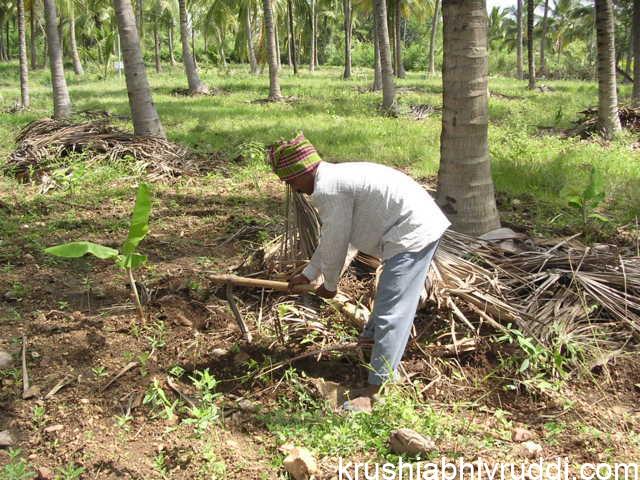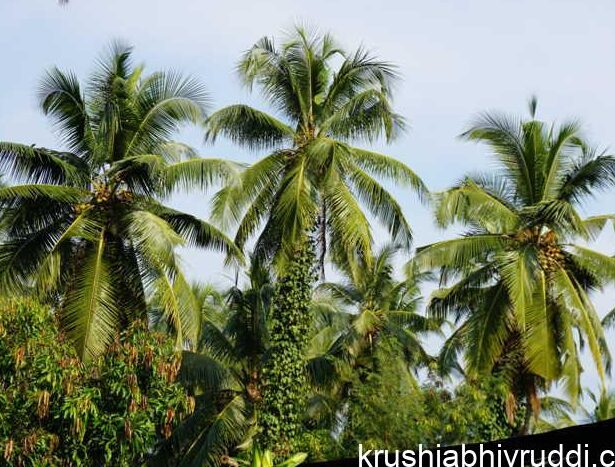Coconut (Cocos nucifera), the “tree of life,” is a tropical palm widely cultivated for its economic and cultural significance. For healthy growth, high yield, and disease resistance, understanding its root system is crucial—especially when deciding where to apply manure or fertilizers.
Coconut Root System – A Brief Overview
Coconut has a fibrous root system and lacks a central taproot. Roots emerge from the base of the stem (called the bole) and spread outward and downward. A well-grown coconut palm can have 2,000 to 3,000 primary roots, and many of these generate fine absorbing roots responsible for water and nutrient uptake.
These roots extend horizontally up to 6 meters and vertically up to 1.5 meters in depth. However, the majority of absorbing roots are found within a radius of 1.5 to 2 meters from the trunk and concentrated in the top 30 to 60 cm soil layer.
Absorbing Area – Where Nutrients Are Actually Taken Up
The main absorbing roots, which are thin and white in color, occur mainly in the peripheral zone, not at the base of the trunk. These roots are extremely sensitive and highly efficient at absorbing water and nutrients, but only if manures or fertilizers are placed in the correct zone.
Unfortunately, many farmers still place fertilizers close to the base of the palm, assuming it’s the best feeding point. This is a common but harmful mistake. The area around the bole contains supporting roots, not absorbing ones. Fertilizers placed there are not effectively taken up and may leach away or even cause root rot and collar infections due to excess salt accumulation and moisture retention.
The Correct Manuring Zone
To ensure maximum absorption, fertilizers and organic manures should be placed in the active root zone:
- Distance: 1.5 to 2 meters from the trunk, in a circular pattern.
- Depth: 15 to 30 cm, as most feeder roots are near the soil surface.
- Method: Dig a circular trench or basin of 30–45 cm width around the palm.
This approach encourages better uptake of nutrients, reduces wastage, and enhances microbial activity in the rhizosphere.

How Much Manure or Fertilizer Should Be Applied?
For adult coconut palms (above 5 years), the general nutrient recommendation per palm per year is:
- FYM (Farm Yard Manure): 50 kg
- Nitrogen (N): 500 g
- Phosphorus (P₂O₅): 320 g
- Potassium (K₂O): 1200 g
These can be split into two or three equal doses and applied before monsoon (June), after monsoon (September), and optionally in summer (February–March) along with adequate irrigation or rainfall.
Impact of Root Damage
Coconut roots, especially the feeder roots, are delicate. Careless ploughing, digging, or overuse of chemical fertilizers can damage these absorbing roots, leading to:
- Reduced water and nutrient uptake
- Yellowing of leaves
- Stunted growth
- Poor nut development
- Greater vulnerability to diseases like stem bleeding and root wilt
Maintaining root health is vital. Use of organic matter and biofertilizers like Azospirillum, Phosphobacteria, and mycorrhiza can enhance root function and protect them from stress.
Root System and Its Relation with Crown (Leaf Area)
The health of the root system directly influences the crown (leaf area and leaf number). A healthy, deep, and wide-spreading root network supports:

- Better leaf growth
- Higher photosynthetic activity
- Greater number of functional leaves
- Formation of more inflorescences and fruit set
If the root system is damaged or undernourished, the crown becomes sparse, leaf tips dry up, and nut setting becomes erratic.
Hence, crown vigor is a mirror of the root zone health. Ensuring proper manure placement supports a strong root system, which in turn results in dense leaf canopy, good flowering, and consistent nut yield.
In coconut cultivation, “where” you place the manure is as important as “how much” you apply. Always place manures and fertilizers 1.5 to 2 meters away from the trunk, in the active root zone, and avoid applying them near the base. This small change in practice can significantly boost nutrient uptake, improve root health, and ultimately enhance yield and palm longevity. A healthy root ensures a healthy crown—and that’s the key to successful coconut farming.











